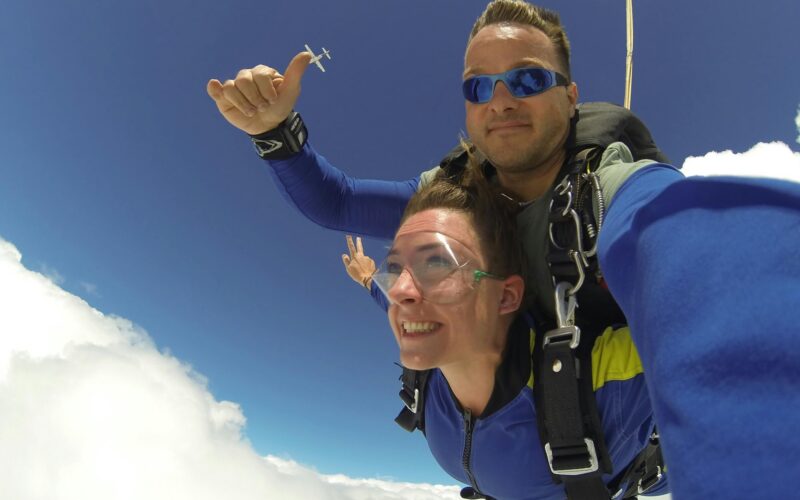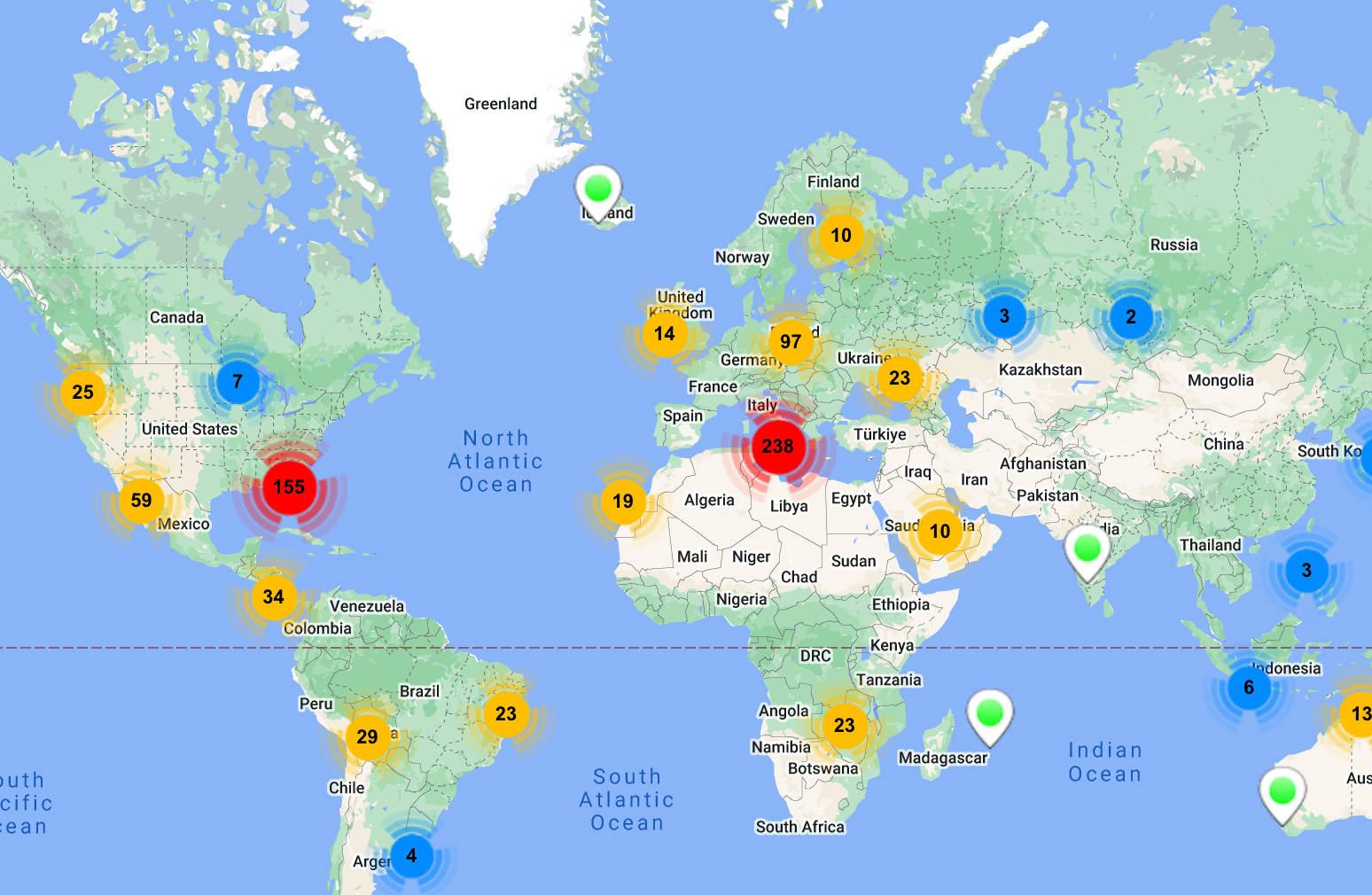Safety
Is Skydiving Safe? Find Out the Truth About the Risks of Skydiving
All the information you need to understand the inherent risks of skydiving.

Skydiving is probably one of the most common bucket-list items across world. Us humans are drawn to it like a moth to a flame.
But most people don’t think it’s worth the risk.
Which raises a few questions: What is the risk? Is skydiving safe? Or is it plagued with risks and dangers that make it ridiculous to even consider the idea of jumping out of a plane?
Let’s find out…
Real-Life Skydiving Safety Statistics
Skydiving might seem like a wild ride, but the stats tell a different story…
According to PubMed Central, out of over 62 million jumps, the injury rate is a tiny 0.044%, and the fatality rate is an even tinier 0.0011%.
So, while accidents do happen, they’re pretty rare.
In 2023, according to the United States Parachute Association (USPA), civilian skydiving fatalities in the United States hit a record low of 10, matching the milestone first achieved in 2021.
This means that the fatality index rate for 2023 was just 0.27 per 100,000 skydives.
Let’s put that into perspective…
There were 14.2 road traffic deaths per 100,000 inhabitants in the USA in 2021 according to the World Health Organization (WHO).
I know it’s cliche to say it, but yes, driving your car is statistically more dangerous than skydiving.
Tandem Skydiving Safety Statistics
It’s worthwhile pointing out that most skydiving-related injuries and fatalities happen on solo skydives. But if you’re considering trying skydiving for the first time, you’ll probably be doing a tandem skydive with a trained and qualified professional.
In tandem skydiving, you’ll be securely strapped to a qualified instructor when you make your jump.
After freefalling for a few thousand feet, the instructor pops the parachute open and takes care of everything so that you can just enjoy the ride. If you’re lucky, the instructor might even let you play around with some canopy control.
So how safe is Tandem Skydiving?
Well, the injury rate for tandem skydiving is around 1 in every 1,400 jumps, with women slightly more likely to get hurt (1 in 1,200) compared to men (1 in 1,600).
But more importantly, since 1990, the fatality rate for tandem jumps is super low… about 0.11 per 100,000 jumps.
According to British Skydiving, there haven’t been any tandem fatalities in the UK from 2003 to 2022.
Safety Equipment Used in Skydiving
Another important part of skydiving safety is the development of safety equipment. If you’re trying skydiving for the first time, you’ll be taking part in a tandem dive with a qualified instructor who will take care of all the safety equipment.
But it’s worthwhile having a general understanding of some of the items that have been invented to guarantee to don’t splat on the ground like a squashed tomato.
- Main Parachute: A parachute deployed to slow the descent during a jump.
- Reserve Parachute: A backup parachute deployed in case of malfunction of the main parachute.
- Automatic Activation Device (AAD): A device that deploys the reserve parachute at a predetermined altitude if it has not been done so manually by the skydiver.
- Container: This part of the rig holds both the main and the reserve parachute, as well as the AAD. In layman’s terms, it’s the backpack that holds your chutes.
- Altimeter: It is basically a wrist-mounted device alerting a skydiver about their altitude to let them know when to deploy the parachute.
- Harness: The safety harness is what securely connects the container to the skydiver. In the case of tandem jumps, the harness also connects you to your qualified skydiving instructor.
- Helmet: To prevent unexpected head injuries while in freefall or in the case of a rough landing.
Remember, when it comes to solo diving, no safety equipment in the world can replace sound training.
The Role of AAD Devices in Skydiving Safety
Automatic Activation Devices, or AADs, are devices necessary to modern skydiving equipment, enhancing safety during a jump.
The devices automatically deploy the reserve parachute in case the skydiver has not activated their main parachute by a certain altitude, usually around 750 feet.
The primary function of an AAD is to add increased safety, particularly for the new jumper but also in unusual circumstances when a skydiver may become incapacitated or disoriented.
FAA Riggers – Your Guardian Angels
FAA riggers play a crucial role in the safety and reliability of skydiving equipment. These certified professionals are responsible for the packing, maintenance, and inspection of parachutes, ensuring that all gear meets stringent safety standards established by the Federal Aviation Administration.
Their expertise is essential not just in preparing the main and reserve parachutes for use, but also in identifying any potential flaws or wear in the equipment that could lead to malfunctions during a jump.
Riggers undergo extensive training to become certified, including hands-on experience that equips them with the skills necessary to handle the various designs and mechanisms of parachuting gear.
Through proper rigging and regular inspections, FAA riggers greatly reduce the risks and increase overall safety for all skydivers.
Governing Organizations for Skydiving Standards in Different Countries
Knowing the bigger governing bodies that come into play in setting the safety and operational standards around the world when skydiving is very important. Here are some of the main bodies responsible for skydiving regulations in various countries:
- United States: United States Parachute Association (USPA)
- United Kingdom: British Skydiving
- Australia: Sport Aviation Australia (SAAA) and Australian Parachute Federation (APF)
- Canada: Canadian Sport Parachuting Association (CSPA)
- New Zealand: New Zealand Parachute Industry Association (NZPIA)
- Germany: Deutscher Fallschirmsportverband (DFV)
- France: Fédération Française de Parachutisme (FFP)
- South Africa: Parachute Association of South Africa (PASA)
- Netherlands: Koninklijke Nederlandse Vereniging voor Luchtvaart (KNVvL)
- Sweden: Svenska Fallskärmsförbundet (SFF)
These organizations play a vital role in ensuring safety, offering training programs, and setting operational guidelines for skydiving across their respective countries.
Choosing a Reputable and Licensed Skydiving Center
Safety starts with the selection of the right skydiving center.
Read reviews and ask for referrals from friends or family who have gone skydiving before. Good experiences don’t necessarily reflect the safety of a particular center but they should at least be a good indicator.
Once you’ve found a skydiving center that you like, you should check to see if it is accredited by the organization that sets the safety standards within your country, as outlined in the previous section of this post.
Get started with our skydiving center search tool now!
Tips for Personal Safety Measures and Mental Preparation
While the professionals handle most safety aspects, there are steps you can take to ensure a safe and enjoyable experience:
- Follow Instructions: Listen carefully to your instructor’s guidance and follow all safety protocols.
- Stay Calm: It’s natural to feel nervous, but staying calm helps you react better to instructions and enjoy the experience.
- Check Weather Forecasts: While the center will monitor weather conditions, knowing the forecast can help you mentally prepare for potential delays.
- Hydrate and Eat Lightly: Ensure you’re well-hydrated and have eaten lightly before your jump to avoid discomfort.
So, Is Skydiving Actually Safe?
Well… while any extreme sport comes with inherent risks, skydiving has become increasingly safer over the years. With proper training, equipment, and choosing a reputable skydiving center, your experience is bound to be unforgettable and most importantly safe.
Published: August 15, 2024 | Last Updated: August 15, 2024
Don’t miss an update!
Join our mailing list for the latest indoor skydiving updates delivered directly to your inbox.




While many people may view skydiving as a risky activity, statistics actually show that you are more likely to be injured or killed in a car accident than during a skydiving jump. Do you think society’s perception of skydiving safety is skewed compared to the actual data?”,
“refusal